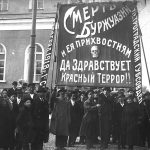
Bolshevik Occupation Former Colonies: Imperialism Born in Blood

The simultaneous collapse of the Russian, German, and Austro-Hungarian empires gave nations a chance to free themselves from artificial state formations glued together from mismatched fragments. It was an inevitable process — the weakening of an imperial center always leads to the disintegration of its periphery. This pattern has repeated throughout history — and it will repeat again, as long as the last empire, the Russian Federation still exist. For Eastern Europe and Asia, that collapse marked only the beginning of a longer struggle. The Bolshevik occupation of former colonies that followed tried to reverse the very course of history — to rebuild an empire that the world had already buried.
The fall of the Russian Empire triggered a massive wave of independence. The Baltic states, Ukraine, Poland, Finland, and the Caucasus broke away. Even Siberia drifted from the center. Those who saw themselves as occupied and enslaved declared independence and began building their own states. However, the Bolsheviks had their own theory — the world revolution — which was supposed to conquer the entire planet. And they decided to begin this “revolution” by reoccupying the very colonies that had just broken away.
From Imperialism to Super-Imperialism
While other colonial powers pursued classic imperialism driven by economic motives — controlling trade routes and resource deposits — the Bolsheviks rode the wave of a new ideology: neo-imperialism. In fact, what they built can be called super-imperialism. Traditional empires expanded for profit; the Bolsheviks aimed to subjugate the entire world, absorbing all empires, all routes, and all resources. In essence, they sought to create an absolute empire.
To that end, they reintegrated Siberia, Central Asia, the Caucasus, and Ukraine. By that time, local self-government had already been established in all these regions, and Ukraine had already achieved international recognition from most of the world’s leading nations. Poland resisted, and Finland was left for “later.”
“Revolutionary Campaigns” or Plain Conquest
This reoccupation of former colonies was branded as a so-called “revolutionary campaign.” Yet on the ground, no one needed such a “revolution.” It had to be carried out at bayonet point, massacring the local population. That was true everywhere.
In essence, this was the Bolshevik occupation of former colonies — a campaign of terror disguised as liberation. By its historical and legal nature, it was nothing but imperialist occupation. It had nothing to do with restoring borders or reclaiming lost lands — it was pure conquest.
Denying Imperial Succession
The Bolsheviks formally denied any continuity with the Russian Empire. Accepting succession would have meant inheriting debts and obligations from World War I. Creditors demanded payment, but Moscow refused any link to the old empire.
For that, the Sovok* ended up in isolation. Thus, the reoccupation of former colonies was, in fact, an act of aggression and invasion — followed soon after by wars with Poland and Finland.
Rebuilding the Empire Through War
Wave after wave, the “proletariat” and its vanguard — the Workers’ and Peasants’ Red Army — occupied most of the former colonies of the Empire. They came to foreign lands, fully aware they were foreign, and imposed the bloody order of their new metropole. Small nations of Siberia and the Far North vanished without a trace. The Bolsheviks imposed not only their system but also their way of thinking.
And from all this arises one simple question: did they ever stop being occupiers? Obviously not. It remained an imperialist, occupation regime that, unlike classical empires, sought to erase the very spirit of the conquered peoples — turning them into a faceless herd, rootless and nameless, as it was in the metropole itself.
Colonial Wars and Monuments of Lies
Every war the Sovok waged — forcing colonized populations to fight — always served the metropole’s interests and harmed the colonies. Always. The metropole itself admitted this through the countless monuments of the Soviet era.
In seventy years of existence, the USSR never erected a single monument to the millions of Ukrainians who died a horrific death in the artificial famine. Because Ukraine was a colony — and the death of its people was just statistics. The very fact of this genocide was denied, and in Moscow it is still denied today, since recognition would entail consequences — after all, Russia officially declared itself the USSR’s successor.
All right, let’s assume it happened somewhere in remote, isolated regions. Let’s also assume the Sovok “didn’t know” about this horror — just like the Germans supposedly “didn’t know” about Buchenwald, Auschwitz, or Majdanek. Let’s assume that was truly the case.
But then came the catastrophic explosion of the DniproHES dam — about 120,000 Ukrainians drowned downstream. Could anything be louder than that? Yet the Sovok built no memorial there. Instead, they filled the land with thousands of Lenins, mounted butchers, and other monuments to their own evil. Such silence was not accidental — it was part of the same Bolshevik occupation of former colonies, where human life meant nothing, and memory itself was treated as an enemy to be erased.
*Sovok — sarcastic abbreviation for “Soviet Union,” derived from “Sovetskiy Soyuz”. The word also means “dustpan,” carrying a double connotation of trashiness and backwardness.
Related posts:


Severomuysky Tunnel Explosion: Blasts in Russia’s Secret Railway
By Thursday evening, numerous sources confirmed the fact of sabotage inside the Severomuysky Tunnel of the Baikal-Amur Railway in the garbage federation. We had to wait for more [...]
The Losers Club: the Swamps, Iran, and North Korea
The past century unfolded in a confrontation between two political-economic realities — capitalist and socialist. The first resulted from centuries-long evolution of social relations. The second turned out [...]